Abstract
Alpha-factor-mediated cell cycle arrest and mating inhibition of a mating-type cells of Saccharomyces cerevisiae have been examined in liquid cultures. Cell cycle arrest may be monitored unambiguously by the appearance of morphologically abnormal cells after administration of alpha factor, whereas mating inhibition is determined by comparing the mating efficiency in the absence or presence of added alpha factor. For both cell cycle arrest and mating inhibition, a dose-dependent response may be observed at limiting concentrations of the pheromone. If cell cycle arrest and mating inhibition require a small number of alpha-factor molecules, one might expect that responsive/nonresponsive cells = K(alpha factor)N where N is the order of dependence of cell cycle arrest (or mating inhibition) on alpha-factor concentration. The value of N has been determined to be 0.98 ± 0.18 (standard error of the mean) for cell cycle arrest and 1.08 ± 0.32 for mating inhibition. These results support the notion that saturation of a single site by alpha factor is sufficient to cause cell cycle arrest or mating inhibition of a mating-type cells.
Full text
PDF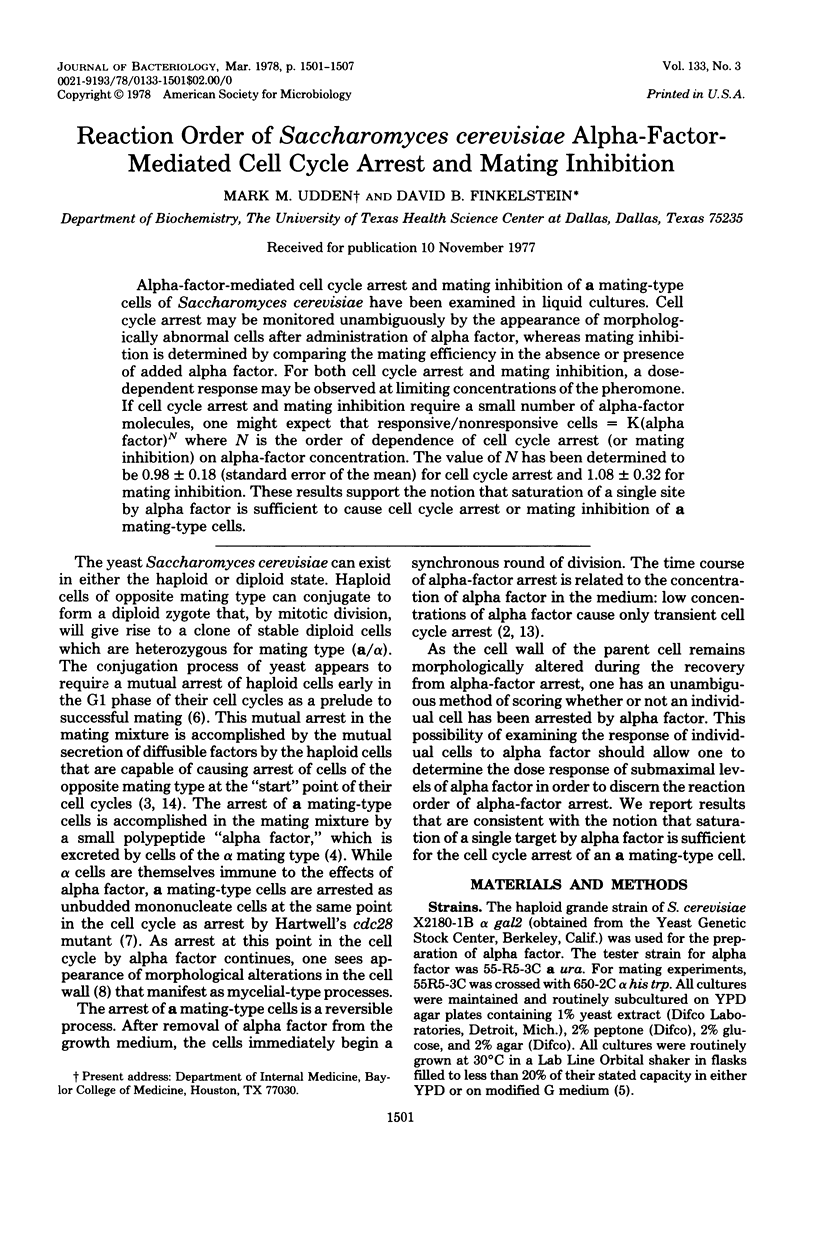
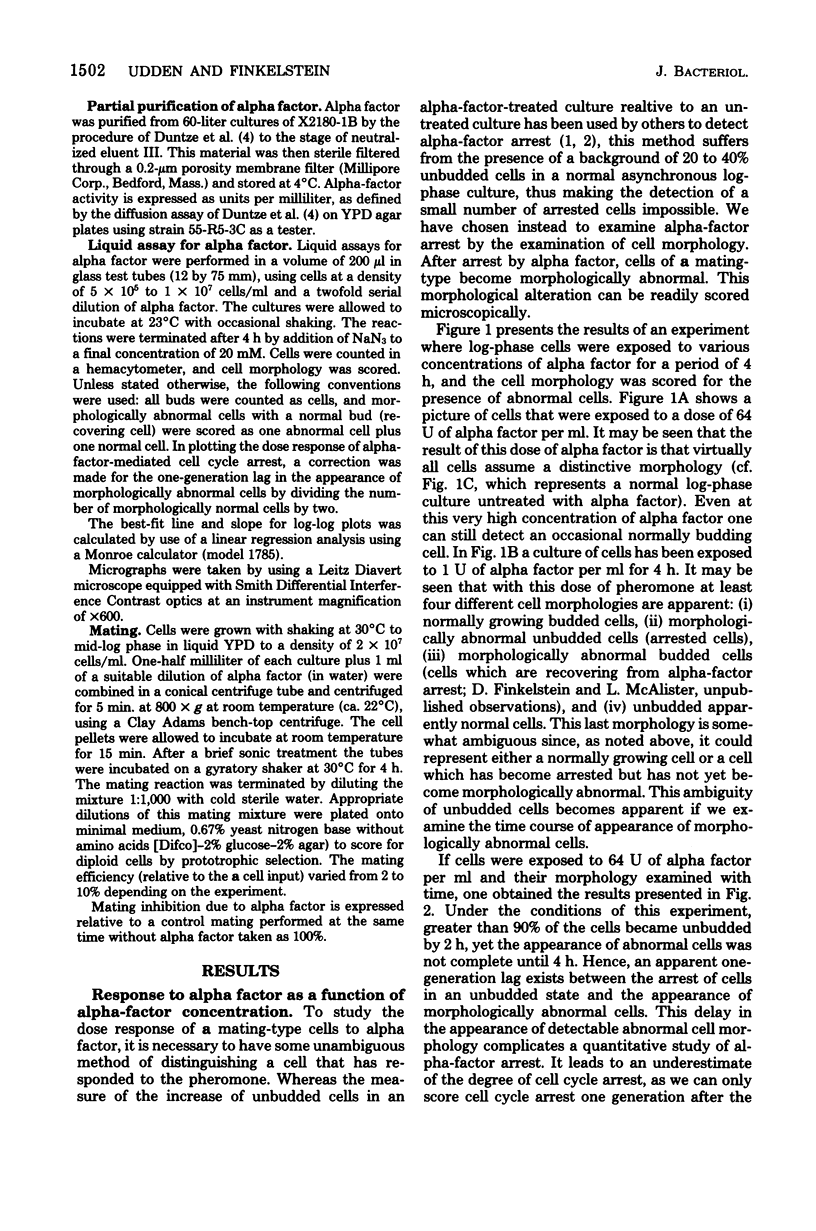
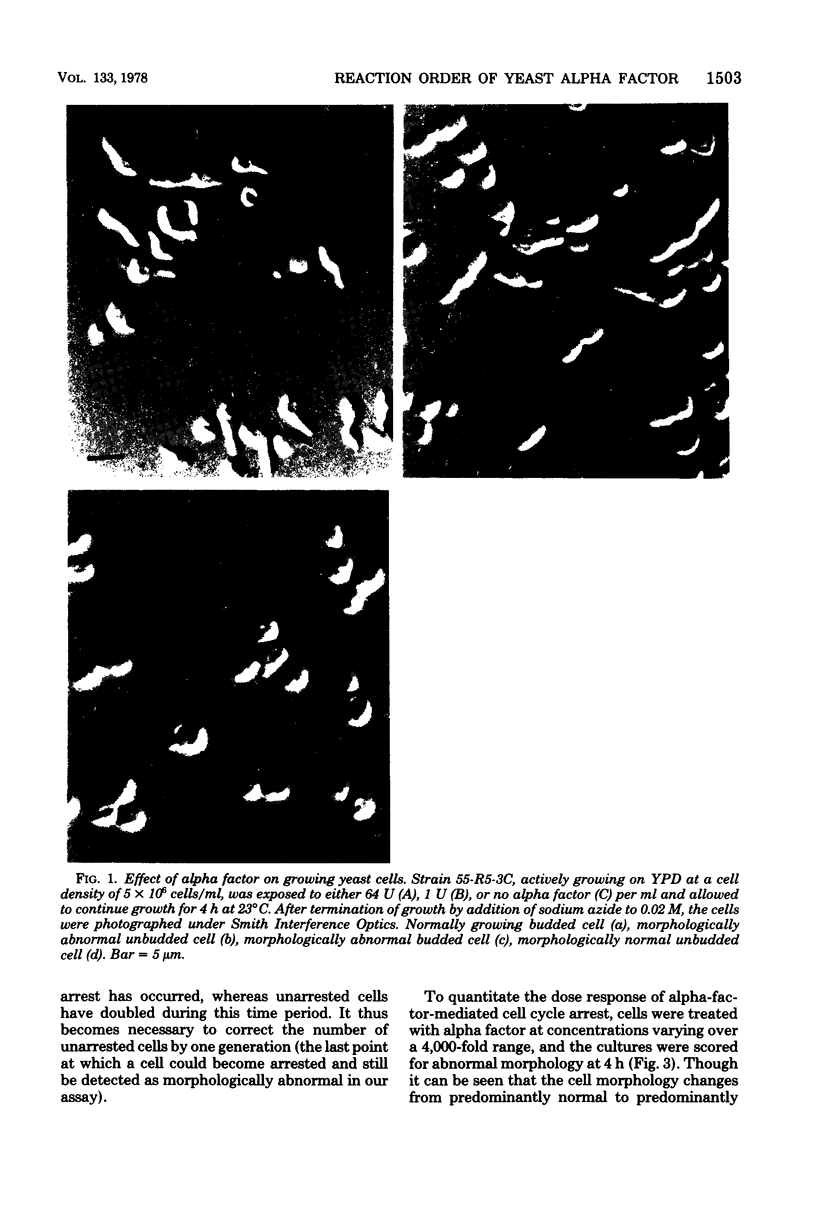


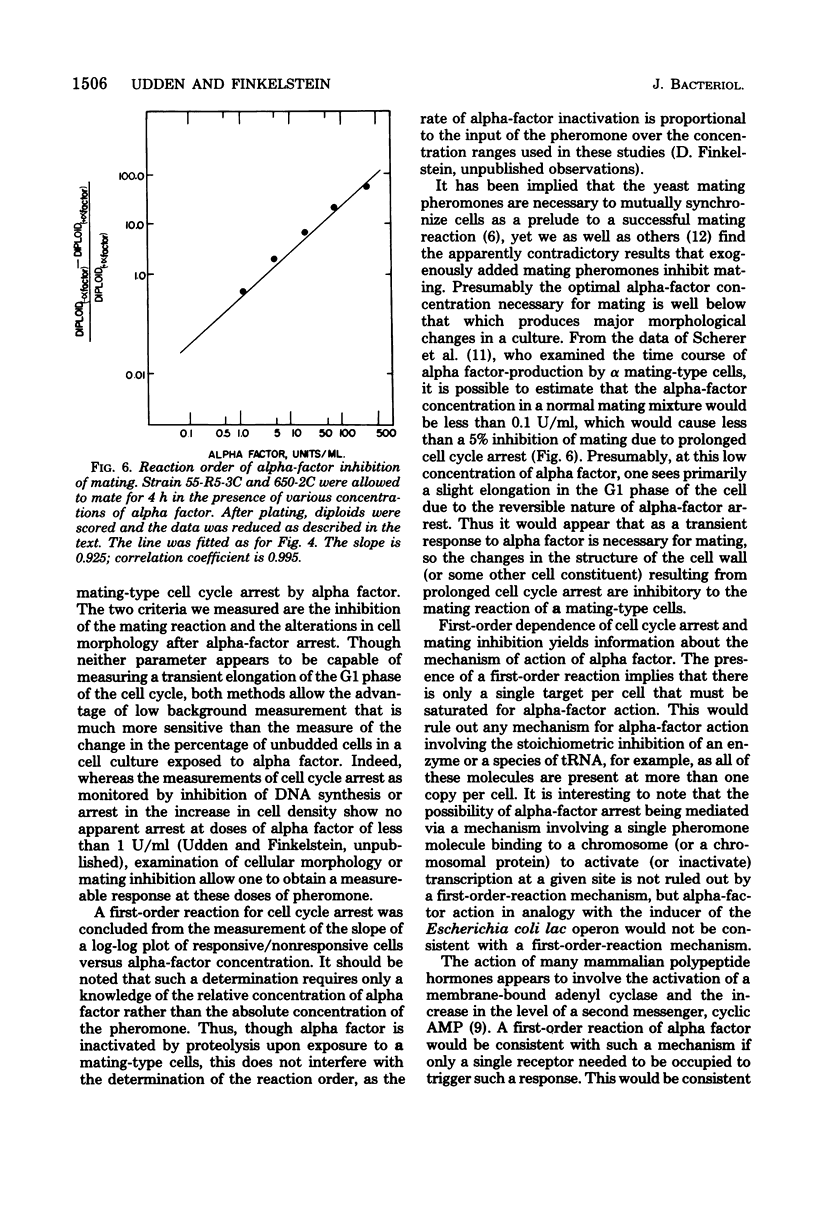
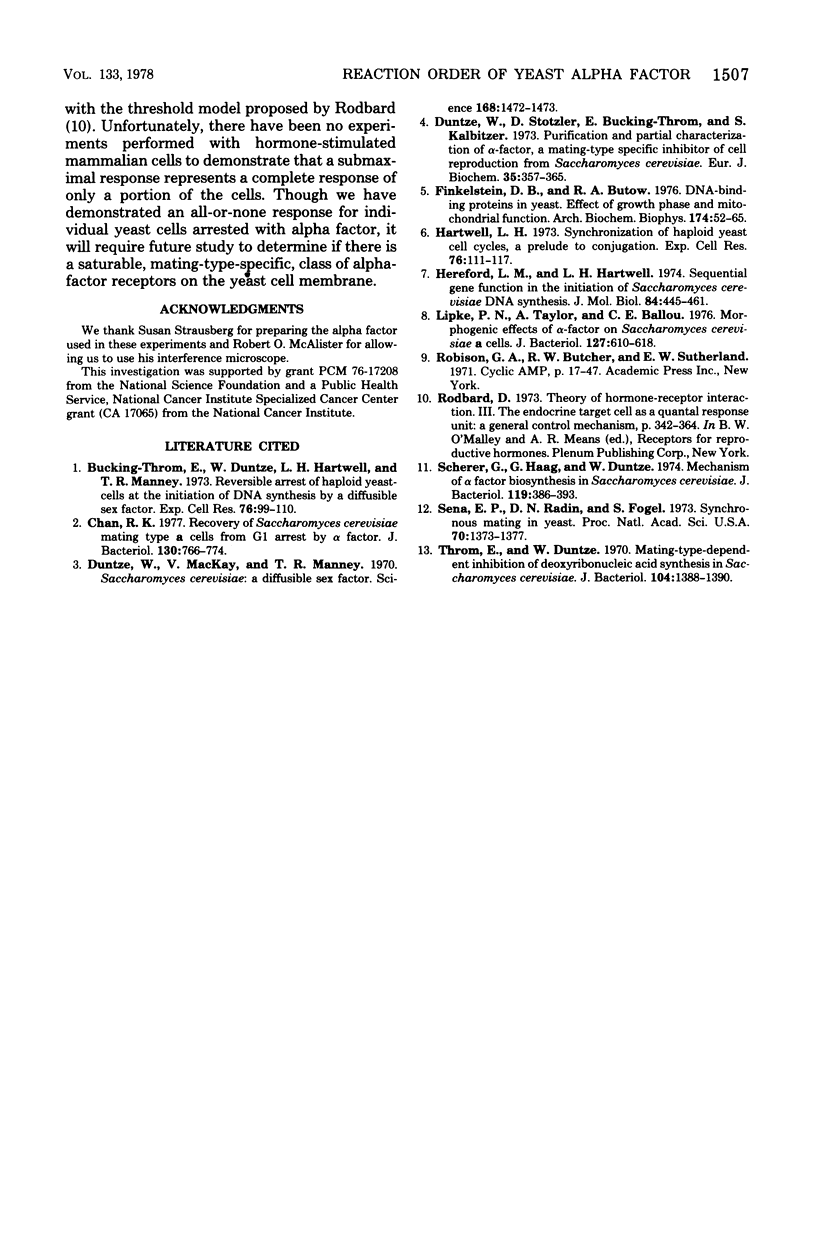
Images in this article
Selected References
These references are in PubMed. This may not be the complete list of references from this article.
- Bücking-Throm E., Duntze W., Hartwell L. H., Manney T. R. Reversible arrest of haploid yeast cells in the initiation of DNA synthesis by a diffusible sex factor. Exp Cell Res. 1973 Jan;76(1):99–110. doi: 10.1016/0014-4827(73)90424-2. [DOI] [PubMed] [Google Scholar]
- Chan R. K. Recovery of Saccharomyces cerevisiae mating-type a cells from G1 arrest by alpha factor. J Bacteriol. 1977 May;130(2):766–774. doi: 10.1128/jb.130.2.766-774.1977. [DOI] [PMC free article] [PubMed] [Google Scholar]
- Duntze W., MacKay V., Manney T. R. Saccharomyces cerevisiae: a diffusible sex factor. Science. 1970 Jun 19;168(3938):1472–1473. doi: 10.1126/science.168.3938.1472. [DOI] [PubMed] [Google Scholar]
- Duntze W., Stötzler D., Bücking-Throm E., Kalbitzer S. Purification and partial characterization of -factor, a mating-type specific inhibitor of cell reproduction from Saccharomyces cerevisiae. Eur J Biochem. 1973 Jun;35(2):357–365. doi: 10.1111/j.1432-1033.1973.tb02847.x. [DOI] [PubMed] [Google Scholar]
- Finkelstein D. B., Butow R. A. DNA-binding proteins in yeast. Effect of growth phase and mitochondrial function. Arch Biochem Biophys. 1976 May;174(1):52–65. doi: 10.1016/0003-9861(76)90323-4. [DOI] [PubMed] [Google Scholar]
- Hartwell L. H. Synchronization of haploid yeast cell cycles, a prelude to conjugation. Exp Cell Res. 1973 Jan;76(1):111–117. doi: 10.1016/0014-4827(73)90425-4. [DOI] [PubMed] [Google Scholar]
- Hereford L. M., Hartwell L. H. Sequential gene function in the initiation of Saccharomyces cerevisiae DNA synthesis. J Mol Biol. 1974 Apr 15;84(3):445–461. doi: 10.1016/0022-2836(74)90451-3. [DOI] [PubMed] [Google Scholar]
- Lipke P. N., Taylor A., Ballou C. E. Morphogenic effects of alpha-factor on Saccharomyces cerevisiae a cells. J Bacteriol. 1976 Jul;127(1):610–618. doi: 10.1128/jb.127.1.610-618.1976. [DOI] [PMC free article] [PubMed] [Google Scholar]
- Rodbard D. Theory of hormone-receptor interaction. 3. The endocrine target cell as a quantal response unit: a general control mechanism. Adv Exp Med Biol. 1973;36(0):342–364. [PubMed] [Google Scholar]
- Scherer G., Haag G., Duntze W. Mechanism of alpha factor biosynthesis in Saccharomyces cerevisiae. J Bacteriol. 1974 Aug;119(2):386–393. doi: 10.1128/jb.119.2.386-393.1974. [DOI] [PMC free article] [PubMed] [Google Scholar]
- Sena E. P., Radin D. N., Fogel S. Synchronous mating in yeast. Proc Natl Acad Sci U S A. 1973 May;70(5):1373–1377. doi: 10.1073/pnas.70.5.1373. [DOI] [PMC free article] [PubMed] [Google Scholar]
- Throm E., Duntze W. Mating-Type-Dependent Inhibition of Deoxyribonucleic Acid Synthesis in Saccharomyces cerevisiae. J Bacteriol. 1970 Dec;104(3):1388–1390. doi: 10.1128/jb.104.3.1388-1390.1970. [DOI] [PMC free article] [PubMed] [Google Scholar]



